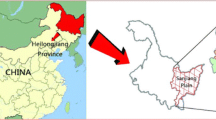Abstract
Based on the Theory of Complex Adaptive System developed recently, a holistic model for water resources system is established at the basin level for analyzing water resources management and allocation of the basin. In this holistic model framework, the subsystems of the water resources system, including hydrologic components, agricultural and industrial production, human living, ecosystem and enviorenment are combined in a dynamic connection with inner variables. According to the characteristics of the holistic model framework, a nesting genetic arithmetic is employed to solve the nonlinear optimal model. The model is applied in the Yellow River basin to analyze the rational amount of diversion water for the West Line of Water Transfer Project form South China to North China and its marginal benifit.
Similar content being viewed by others
References
Noel, J. E., Howitt, R. E., Conjunctive multibas in management: An optimal control approach. Water Resources Research, 1982, 18(4): 753–763.
Lefkoff, L. J., Gorelick, S. M., Simulating physical processes and economic behavior in saline, inigated agricultue: Model development. Water Resources Research, 1990a, 26(7): 1359–1369.
Lefkoff, L. J., Gorelick, S. M., Benefits of an inigation water rental market in a saline stream-aquifer system, Water Resources Research, 1990b, 26(7): 1371–1381.
Lee, D. J., Howitt, R. E., Modeling regional agricultural production and salinity control alternatives forwater quality policy analysis, American Journal of Agricultural Economics, 1996, 78(1): 41–53.
Xu Xinyi, Wang Hao, Gan Hong, Macro-Economic Water Resources Planning in Northwest China: Theory and Method (in Chinese), Zhengzhou: Yellow River Press, 1997.
Harding, B. J., Sangoyomi, T. B., Payton, E. A., Impacts of a severe drought on Colorado river water resources. Water Resources Bulletin, 1995, 31(5): 815–824.
Booker, J. F., Hydrologic and economic impacts of drought under alternative policy responses, Water Resources Bulletin, 1995, 31(5): 889–907.
Booker, J. F., Young, R. A., Modeling intrastate and interstate, markets for Colorado river water resources, Journal of Environmental Economics and Management, 1994, 26(1): 66–87.
Henderson, J. L., Lord, W. B., A gaming evaluation of Colorado river drought management institutional options, Water Resources Bulletin, 1995, 31(5): 907–924.
Cai Ximing, A flamework for sustainability analysis in water resources management and application to the Syr Darya Basin, Water Resources Research, 2002, 38(10): 1029.
Holland, J. H., Emergence, Addison-Wesley, 1998.
Holland, J. H., Hidden Order, Addidon-Wesley Publishing Company, Inc., 1994.
Holland, J. H., Emergence, Addidon-Wesley Publishing Company, Inc., 1998.
Wackernagel, M., National natural capital accounting with ecological footprint concept, Ecological Economics, 1999, 29: 375–390.
Wang Zhongjing, Zhao Jianshi, Approach On Multi-Objective Scenario Analysis Of Water Resources Carrying Capacity, Beijing: International Conference of Water Resources for the Sustainable Development of Big Cities in Early 21st Century, 2000, 135–146.
Shi Huibin, Weng Wenbin, Theory and application of interactive Tchebycheff method for multi-object analysis, Theories and Practices of System Engineering (in Chinese), 1995(9): 27–35.
Cai, X., McKinney, D. C., Lasdon, L., Piece-by-piece approach for solving large nonlinear water resources management model, J. of Water Resources Planning and Management (ASCE), 2001, 127(6): 363–368.
Author information
Authors and Affiliations
Corresponding author
Rights and permissions
About this article
Cite this article
Zhao, J., Wang, Z. & Weng, W. Study on the holistic model for water resources system. Sci. China Ser. E-Technol. Sci. 47 (Suppl 1), 72–89 (2004). https://doi.org/10.1360/04ez0007
Received:
Issue Date:
DOI: https://doi.org/10.1360/04ez0007




